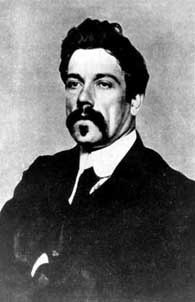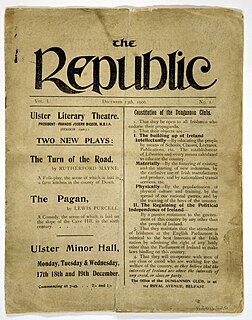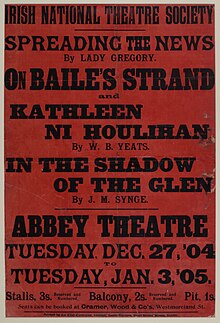
William Butler Yeats was an Irish poet, dramatist, writer and one of the foremost figures of 20th-century literature. He was a driving force behind the Irish Literary Revival and became a pillar of the Irish literary establishment who helped to found the Abbey Theatre. In his later years he served two terms as a Senator of the Irish Free State.

John MacBride was an Irish republican and military leader. He was executed by the British government for his participation in the 1916 Easter Rising in Dublin.

The Abbey Theatre, also known as the National Theatre of Ireland, in Dublin, Ireland, is one of the country's leading cultural institutions. First opening to the public on 27 December 1904, and moved from its original building after a fire in 1951, it has remained active to the present day. The Abbey was the first state-subsidized theatre in the English-speaking world; from 1925 onwards it received an annual subsidy from the Irish Free State. Since July 1966, the Abbey has been located at 26 Lower Abbey Street, Dublin 1.

Isabella Augusta, Lady Gregory was an Irish dramatist, folklorist and theatre manager. With William Butler Yeats and Edward Martyn, she co-founded the Irish Literary Theatre and the Abbey Theatre, and wrote numerous short works for both companies. Lady Gregory produced a number of books of retellings of stories taken from Irish mythology. Born into a class that identified closely with British rule, she turned against it. Her conversion to cultural nationalism, as evidenced by her writings, was emblematic of many of the political struggles to occur in Ireland during her lifetime.

Maud Gonne MacBride was an English-born Irish republican revolutionary, suffragette and actress. Of Anglo-Irish descent, she was won over to Irish nationalism by the plight of people evicted in the Land Wars. She actively agitated for Home Rule and then for the republic declared in 1916. During the 1930s, as a founding member of the Social Credit Party, she promoted the distributive programme of C. H. Douglas. Gonne was well known for being the muse and long-time love interest of Irish poet W. B. Yeats.

Edmund John Millington Synge was an Irish playwright, poet, writer, collector of folklore, and a key figure in the Irish Literary Revival. His best known play The Playboy of the Western World was poorly received, due to its bleak ending, depiction of Irish peasants, and idealisation of parricide, leading to hostile audience reactions and riots in Dublin during its opening run at the Abbey Theatre, Dublin, which he had co-founded with W. B. Yeats and Lady Gregory. His other major works include In the Shadow of the Glen (1903), Riders to the Sea (1904), The Well of the Saints (1905), and The Tinker's Wedding (1909).
The Irish Literary Revival was a flowering of Irish literary talent in the late 19th and early 20th century. It includes works of poetry, music, art, and literature.
Events in the year 1904 in Ireland.
Events in the year 1902 in Ireland.

Kathleen Ni Houlihan is a mythical symbol and emblem of Irish nationalism found in literature and art, sometimes representing Ireland as a personified woman. The figure of Kathleen Ni Houlihan has also been invoked in nationalist Irish politics. Kathleen Ni Houlihan is sometimes spelled as Cathleen Ni Houlihan, and the figure is also sometimes referred to as the Sean-Bhean Bhocht, the Poor Old Woman, and similar appellations. Kathleen Ni Houlihan is generally depicted as an old woman who needs the help of young Irish men willing to fight and die to free Ireland from colonial rule, usually resulting in the young men becoming martyrs for this cause, the colonial power being the United Kingdom. After the Anglo-Irish War, Kathleen Ni Houlihan became associated with the Irish Republican Army in Northern Ireland, especially during the Troubles.
"The Sean-Bhean bhocht", often spelled phonetically as "Shan Van Vocht", is a traditional Irish song from the period of the Irish Rebellion of 1798, and dating in particular to the lead up to a French expedition to Bantry Bay, that ultimately failed to get ashore in 1796.
The Countess Cathleen is a verse drama by William Butler Yeats in blank verse. It was dedicated to Maud Gonne, the object of his affections for many years.
This is a list of all works by Irish poet and dramatist W. B. Yeats (1865–1939), winner of the 1923 Nobel Prize in Literature and a major figure in 20th-century literature. Works sometimes appear twice if parts of new editions or significantly revised. Posthumous editions are also included if they are the first publication of a new or significantly revised work. Years are linked to corresponding "[year] in poetry" articles for works of poetry, and "[year] in literature" articles for other works.

Iseult Lucille Germaine Gonne was the daughter of the Irish republican revolutionary Maud Gonne and the French politician and journalist Lucien Millevoye, who married the novelist Francis Stuart in 1920.
Spreading the News is a short one-act comic play by Lady Gregory, which she wrote for the opening night of the Abbey Theatre in Dublin, 27 Dec. 1904. It was performed as part of a triple bill alongside William Butler Yeats's "On Baile's Strand" and a revival of the Yeats and Gregory collaborative one-act "Cathleen Ni Houlihan" (1902). Audiences may have dozed through Yeats's play, but Spreading the News was very successful and it is still acted at the Abbey Theatre as late as 1961. Lady Gregory remarked after seeing an early performance of the play that "the audience would laugh so much at 'Spreading the News' that they lost about half the dialogue. I mustn't be so amusing again!"

Beatrice Moss Elvery, RHA was a painter, Irish stained-glass artist and sculptor.

Máire Nic Shiubhlaigh was an Irish actress and republican activist. She started acting in her teens and appeared in the first Irish-language play performed in Ireland. She was a founder-member of the Abbey Theatre and was leading lady on its opening night in 1904, when she played the title role in W.B. Yeats's Cathleen Ni Houlihan. She later joined the Theatre of Ireland, which she helped to found.

The Ulster Literary Theatre was a theatre company in Ulster from 1904 to 1934. It had a differently named precursor in 1902, and by 1915 it was named just the Ulster Theatre. It was founded by Bulmer Hobson and David Parkhill with patronage from Francis Joseph Bigger, who was also its first president.
Helen Laird (1874–1957), was an Irish actress also known as ‘Honor Lavelle’, a costumier, teacher, and feminist.
Maire Quinn was an Irish actress and republican activist, and one of the founding members of the Irish National Theatre Society.












